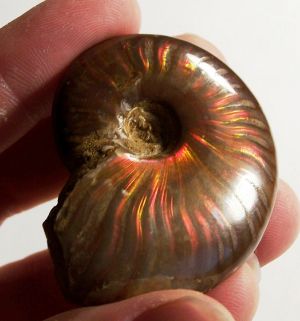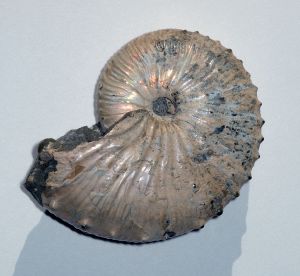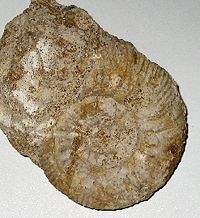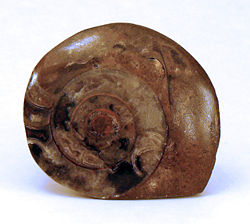| Ammonites
| ||||||||
|---|---|---|---|---|---|---|---|---|
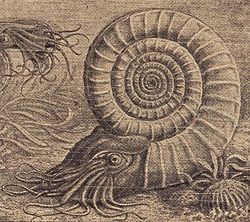 Artist's reconstruction of a live ammonite.
| ||||||||
| Scientific classification | ||||||||
| ||||||||
|
Order Ammonitida
Order Goniatitida
Order Ceratitida
|
Ammonoid or Ammonites are an extinct group of marine animals of the subclass Ammonoidea in the class Cephalopoda, phylum Mollusca. Ammonoidea is one of three subclasses of cephalopods, the others being Coleoidea (octopuses, squids, cuttlefishes, extinct belemites), and Nautiloidea (nautilus and extinct relatives). The Ammonoids appeared in the Paleozoic about 400 million years ago (mya), flourished during the Mesozoic, and became extinct at the close of the Cretaceous 65 mya, along with the dinosaurs.
The words "ammonoid" and "ammonite" are both commonly used to refer to any member of subclass Ammonoidea. However, in stricter usage, the term "ammonite" is reserved for members of suborder (or order) Ammonitina. These have also been referred to as the "true ammonites," while "ammonite" continues to be used for the entire subclass Ammonoidea.
Ammonoids' closest living relative is probably not the modern Nautilus, which they outwardly resemble, but rather the subclass Coleoidea. Their fossil shells usually take the form of planispirals, although there were some helically-spiraled and non-spiraled forms (known as "heteromorphs").
Ammonites' spiral shape gave rise to their name, as their fossilized shells somewhat resemble a tightly-coiled ram's horn. Plinius the Elder (died 79 C.E. near Pompeii) called fossils of these animals ammonis cornua ("horns of Ammon") because the Egyptian god Ammon (Amun) was typically depicted wearing ram's horns. [1] Often the name of an ammonite genus ends in ceras, which is Greek (κέρας) for "horn" (for instance, Pleuroceras).
Ammonoids are excellent index fossils (fossils used to define and identify geologic periods or faunal stages), and it is often possible to link the rock layer in which they are found to specific geological time periods.
Distribution and history
The ammonoids seemed to have diverged from the external shelled nautiloid during the Paleozoic era, likely from within the bactritoid nautiloids. The ammonoid cephalopods first appeared around 400 mya in the Late Silurian to Early Devonian of the Paleozoic era. Ammonoids became extremely abundant, especially as ammonites during the Mesozoic era.
Monks (2006) noted that ammonoids were major players in most marine ecosystems for a very long period of time, from the Devonian through to the Cretaceous (408 to 65 mya). Their bouyant shell allowed them to swim with less effort and provided some defense. Many genera evolved, but a number of forms ran their course quickly, becoming extinct in a few million years. Due to their rapid diversification and widespread distribution, ammonoids are used by geologists and paleontologists for biostratigraphy.
| Phanerozoic eon (542 mya - present) | ||
|---|---|---|
| Paleozoic era | Mesozoic era | Cenozoic era |
The majority of ammonoid specimens, especially those of the Paleozoic era, are preserved only as internal molds; that it to say, the outer shell (composed of aragonite) has been lost through fossilization. It is only in these internal-moldic specimens that the suture lines can be observed; in life the sutures would have been hidden by the outer shell.
| Paleozoic era (542 - 251 mya) | |||||
|---|---|---|---|---|---|
| Cambrian | Ordovician | Silurian | Devonian | Carboniferous | Permian |
The Cretaceous Pierre Shale formation of the United States and Canada is well known for the abundant ammonoid fauna it yields, including Baculites, Placenticeras, Scaphites, Hoploscaphites, and Jeletzkytes, as well as many uncoiled forms. Many of these also have much or all of the original shell, as well as the complete body chamber, still intact. Many Pierre Shale ammonoides, and indeed many ammonoides throughout earth history, are found inside concretions (sedimentary rock in which a mineral cement fills the spaces between the sediment grains).
The ammonoids survived several major extinction events, with often only a few species known to have survived. Each time, however, this handful would diversify into a multitude of forms. Ammonoid fossils became less abundant during the latter part of the Mesozoic, with none surviving into the Cenozoic era.
| Mesozoic era (251 - 65 mya) | ||
|---|---|---|
| Triassic | Jurassic | Cretaceous |
The last surviving lines disappeared along with the dinosaurs 65 million years ago in the Cretaceous-Tertiary extinction event. That no ammonoids survived the extinction event at the end of the Cretaceous, while some nautiloid cousins survived, might be due to differences in ontogeny (development from an egg) to maturity). If their extinction was due to an meteor strike, plankton around the globe could have been severely diminished, thereby dooming ammonoid reproduction during its planktonic stage.
Due to their free-swimming and/or free-floating habits, ammonoids often happened to live directly above seafloor waters so poor in oxygen as to prevent the establishment of animal life on the seafloor. When upon death, the ammonoids fell to this seafloor and were gradually buried in accumulating sediment, bacterial decomposition of these corpses often tipped the delicate balance of local redox conditions sufficiently to lower the local solubility of minerals dissolved in the seawater, notably phosphates and carbonates. The resulting spontaneous concentric precipitation of minerals around a fossil is called a concretion and is responsible for the outstanding preservation of many ammonite fossils.
When ammonites are found in clays, their original mother-of-pearl coating is often preserved. This type of preservation is found in ammonites such as Hoplites from the Cretaceous Gault clay of Folkestone in Kent, England.
Other fossils, such as many found in Madagascar and Alberta (Canada), display iridescence (hue changes according to the angle from which the surface is viewed, due to multiple reflections from multi-layer, semi-transparent surfaces). These iridescent ammonites are often of gem quality (ammolite) when polished. In no case would this iridescence have been visible during the animal's life; additional shell layers covered it.
Size
Few of the ammonites occurring in the lower and middle part of the Jurassic period reach a size exceeding 23 centimeters (9 inches) in diameter. Much larger forms are found in the later rocks of the upper part of the Jurassic and the lower part of the Cretaceous, such as Titanites from the Portland Stone of Jurassic of southern England, which is often 53 centimeters (2 feet) in diameter, and Parapuzosia seppenradensis of the Cretaceous period of Germany, which is one of the largest known ammonites, sometimes reaching 2 meters (6.5 feet) in diameter.
The largest documented North American ammonite is Parapuzosia bradyi from the Cretaceous with specimens measuring 137 centimeters (4.5 feet) in diameter.
Life
Because ammonites and their close relatives are extinct, little is known about their way of life. Their soft body parts are practically never preserved in any detail. Nonetheless, a lot has been worked out by examining ammonoid shells and by using models of these shells in water tanks.
Many ammonoids probably lived in the open water of ancient seas, rather than at the sea bottom. This is suggested by the fact that their fossils are often found in rocks that were laid down under conditions where no bottom-dwelling life is found. Many of them (such as Oxynoticeras) are thought to have been good swimmers with flattened, discus-shaped, streamlined shells, although some ammonoids were less effective swimmers and were likely to have been slow-swimming bottom-dwellers.
Ammonites and their kin probably preyed on fishes, crustaceans, and other small creatures; while they themselves were preyed upon by such marine reptiles, such as mosasaurs. Fossilized ammonoids have been found showing teeth marks from such attacks.
Shell anatomy and diversity
Basic shell anatomy
The chambered part of the ammonoid shell is called a phragmocone. The phragmocone contains a series of progressively larger chambers, called camerae (sing. camera) that are divided by thin walls called septa (sing. septum). Only the last and largest chamber, the body chamber, was occupied by the living animal at any given moment. As it grew, it added newer and larger chambers to the open end of the coil.
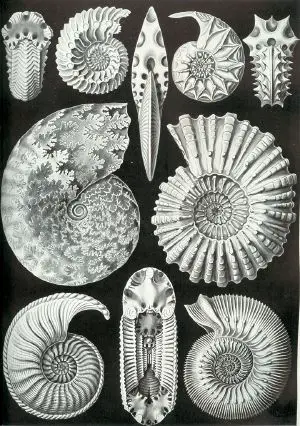
A thin living tube called a siphuncle passed through the septa, extending from the ammonite's body into the empty shell chambers. Through a hyperosmotic active transport process, the ammonite emptied water out of these shell chambers. This enabled it to control the buoyancy of the shell and thereby rise or descend in the water column.
A primary difference between ammonites and nautiloids is that the siphuncle of ammonites (excepting Clymeniina) runs along the ventral periphery of the septa and camerae (i.e., the inner surface of the outer axis of the shell), while the siphuncle of nautiloids runs more or less through the center of the septa and camerae.
Sexual dimorphism
One feature found in shells of the modern Nautilus is the variation in the shape and size of the shell according to the gender of the animal, the shell of the male being slightly smaller and wider than that of the female. This sexual dimorphism is thought to be an explanation to the variation in size of certain ammonoid shells of the same species, the larger shell (called a macroconch) being female, and the smaller shell (called a microconch) being male. This is thought to be because the female required a larger body size for egg production. A good example of this sexual variation is found in Bifericeras from the early part of the Jurassic period of Europe.
It is only in relatively recent years that the sexual variation in the shells of ammonoids has been recognized. The macroconch and microconch of one species were often previously mistaken for two closely related but different species occurring in the same rocks. However, these "pairs" were so consistently found together that it became apparent that they were in fact sexual forms of the same species.
Variations in shape
The majority of ammonoids have a shell that is a planispiral flat coil, but some have a shell that is partially uncoiled, partially coiled, and partially straight (as in Australiceras), nearly straight (as in baculites), or coiled helically—superficially like that of a large gastropod—(as in Turrilites and Bostrychoceras). These partially uncoiled and totally uncoiled forms began to diversify mainly during the early part of the Cretaceous and are known as heteromorphs.
Perhaps the most extreme and bizarre looking example of a heteromorph is Nipponites, which appears to be a tangle of irregular whorls lacking any obvious symmetrical coiling. However, upon closer inspection the shell proves to be a three-dimensional network of connected "U" shapes. Nipponites occurs in rocks of the upper part of the Cretaceous in Japan and the USA.
Ammonoids vary greatly in the ornamentation of their shells. Some may be smooth and relatively featureless, except for growth lines, and resemble that of the modern Nautilus. In others, various patterns of spiral ridges and ribs or even spines are shown. This type of ornamentation of the shell is especially evident in the later ammonites of the Cretaceous.
The aptychus
Like the modern nautilus, many ammonites were probably able to withdraw their body into the living chamber of the shell and developed either a single horny plate or a pair of calcitic plates with which they were able to close the opening of the shell. The opening of the shell is called the aperture. The plates are collectively termed the aptychus or aptychi in the case of a pair of plates, and anaptychus in the case of a single plate. The aptychi were identical and equal in size.
Anaptychi are relatively rare as fossils. They are found representing ammonites from the Devonian period through those of the Cretaceous period.
Calcified Aptychi only occur in ammonites from the Mesozoic era and are normally found detached from the shell and are rarely preserved in place. Still, sufficient numbers have been found closing the apertures of fossil ammonite shells as to leave no doubt as to their intended purpose. (This long-standing and wide-spread interpretation of the function of the aptychus has long been disputed. The latest studies suggest that the anaptychus may have in fact formed part of a special jaw apparatus).
Large numbers of detached aptychi occur in certain beds of rock (such as those from the Mesozoic in the Alps). These rocks are usually accumulated at great depths. The modern Nautilus lacks any calcitic plate for closing its shell, and only one extinct nautiloid genus is known to have borne anything similar. Nautilus does, however, have a leathery head shield (the hood) which it uses to cover the opening when it retreats inside.
There are many forms of aptychus, varying in shape and the sculpture of the inner and outer surfaces, but because they are so rarely found in position within the shell of the ammonite it is often unclear to which species of ammonite many aptychi belong. A number of aptychi have been given their own genus and even species names independent of their unknown owners' genus and species, pending future discovery of verified occurrences within ammonite shells.
Classification
The classification of ammonoids is based in part on the ornamentation and structure of the septa comprising their shells' gas chambers; by these and other characteristics we can divide subclass Ammonoidea into three orders and eight known suborders. While nearly all nautiloids show gently curving sutures, the ammonoid suture line (the intersection of the septum with the outer shell) was folded, forming saddles (or peaks) and lobes (or valleys).
Three major types of suture patterns in Ammonoidea have been noted.
Suture patterns:
- Goniatitic - numerous undivided lobes and saddles; typically 8 lobes around the conch. This pattern is characteristic of the Paleozoic ammonoids.
- Ceratitic - lobes have subdivided tips, giving them a saw-toothed appearance, and rounded undivided saddles. This suture pattern is characteristic of Triassic ammonoids and appears again in the Cretaceous "pseudoceratites."
- Ammonitic - lobes and saddles are much subdivided (fluted); subdivisions are usually rounded instead of saw-toothed. Ammonoids of this type are the most important species from a biostratigraphical point of view. This suture type is characteristic of Jurassic and Cretaceous ammonoids but extends back all the way to the Permian.
The three orders and various suborders of Ammonoidea are herein listed from most primitive to more derived.
Orders and suborders:
- Goniatitida (Devonian to Permian) - have round saddles, pointed lobes
- Anarcestina (Devonian only)
- Clymeniina (upper Upper Devonian only)
- Goniatitina (Devonian to Upper Permian) - includes the true goniatites
- Ceratitida (Carboniferous to Triassic) - have round saddles, serrated lobes
- Prolecanitina (Upper Devonian to Upper Triassic)
- Ceratitina (Permian to Triassic) - includes the true ceratites
- Ammonitida (Permian to Cretaceous) - have folded saddles and lobes, fractal patterns
- Phylloceratina (Lower Triassic to Upper Cretaceous)
- Ammonitina (Lower Jurassic to Upper Cretaceous) - includes the true ammonites
- Lytoceratina (Lower Jurassic to Upper Cretaceous)
- Ancyloceratina (Upper Jurassic to Upper Cretaceous) - the heteromorph ammonites
Ammonoids and humans
In medieval times, ammonites were believed to be petrified snakes. They were frequently fitted with carved snake-like heads and sold to pilgrims. A famous example of this links the ammonite fossils common in the Jurassic sediments around Whitby, North Yorkshire, England, with the legend that Saint Hilda turned a plague of snakes into stone. Even today, tourists can buy ammonite fossils with heads carved onto them to make them look more snake-like.
It is said that the original discus used by the ancient Greeks in their Olympics was in fact a fossilized ammonite; a number of ammonite generic names include an explicit reference to the discus shape (e.g., Sphenodiscus).
In India, ammonite fossils are identified with the god Vishnu and are used in various ceremonies. They are mostly collected in Nepal, from the bed of the River Gandaki where it cuts through Jurassic sediments. These fossils are known as "shaligram shila"[1].
Notes
- ↑ Pliny the Elder. Natural History [37.60.167]. Translated by J. Bostock and H. T. Riley. London: Taylor and Francis. In this section (on precious stones), Pliny writes, "Hammonis cornu is reckoned among the most sacred gems of Æthiopia; it is of a golden colour, like a ram's horn in shape, and ensures prophetic dreams, it is said." The translators note that Hammonis cornu refers to "Horn of [Jupiter] Hammon" and "He here alludes to the Ammonites of modern Geology, an extinct race of molluscous animals that inhabited convoluted shells, and which are commonly known as "snake-stones."
ReferencesISBN links support NWE through referral fees
- Chamot, J. 2003. Deeply buried sediments tell story of sudden mass extinction. National Science Foundation. Retrieved January 20, 2007.
- Larson, N. L., S. D. Jorgensen, R. A. Farrar, and P. L. Larson. 1997. Ammonites and the other Cephalopods of the Pierre Seaway. Geoscience Press.
- Lehmann, U. 1981. The Ammonites: Their life and their World. Cambridge University Press. Translated from German by Janine Lettau.
- Monks, N., and P. Palmer. 2002. Ammonites. Smithsonian. ISBN 1588340473.
- Monks, N. 2006a. A broad brush history of the Cephalopoda. The Cephalopod Page (http://www.thecephalopodpage.org). Retrieved January 20, 2007.
- Monks, N. 2006b. Ammonite maturity, pathology and old age. The Cephalopod Page (http://www.thecephalopodpage.org). Retrieved January 20, 2007.
- Walker, C., and D. Ward. 2002. Fossils. London: Dorling, Kindersley Limited.
External links
All links retrieved July 26, 2023.
- Gallery of ammonite photographs. www.paleozoic.org.
- Descriptions and pictures of ammonite fossils. www.fossilmuseum.net.
Credits
New World Encyclopedia writers and editors rewrote and completed the Wikipedia article in accordance with New World Encyclopedia standards. This article abides by terms of the Creative Commons CC-by-sa 3.0 License (CC-by-sa), which may be used and disseminated with proper attribution. Credit is due under the terms of this license that can reference both the New World Encyclopedia contributors and the selfless volunteer contributors of the Wikimedia Foundation. To cite this article click here for a list of acceptable citing formats.The history of earlier contributions by wikipedians is accessible to researchers here:
The history of this article since it was imported to New World Encyclopedia:
Note: Some restrictions may apply to use of individual images which are separately licensed.
